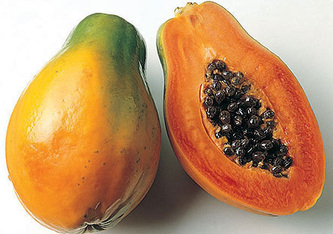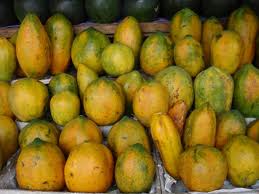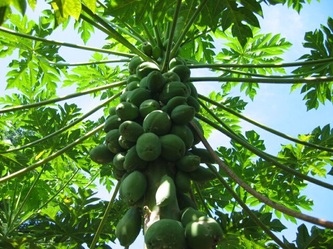 MARIA'S FRUIT & VEGETABLE STAND THE PAPAYA OF CENTRAL AMERICA Papayas are one of the fruits, that I sell the most of, here at my fruit stand in San Pedro. Everyone seems to love papayas, and they are often the one fruit that is available year round, regardless of the season. The papaya plant has various uses, but is most famous for its sweet and tender fruit. Indeed, this South American fruit is one of the most popular in the world, and is now grown in every tropical and subtropical country. The papaya is believed to have originated in southern Mexico and eastern Central America. By the time that the Spanish arrived, the fruit had already spread throughout Central America and into South America. The Spanish were the first to introduce it to Asia in 16th century via the Philippines. The fruit then spread to India and eventually to Europe. By the 19th century, the fruit was already being grown in all tropical regions throughout the world. Today, the fruit can be found in a variety of cultures and their foods, ranging from the savory to the sweet. Though the fast-growing plant resembles a tree, the papaya is actually an herb that reaches 20-30 ft in. height with a rough stem is typically 12-16 in. thick (Morton). The large leaves have long stems (1-3.5 ft) and their blades are spit into 7-11 main lobes. The stems have a dark green to purple color while the leaves are green with yellow ribs and veins. Both contain milky fluid. The papaya has different flowers depending on the sex of the plant. Some herbs bear female (or bisex) flowers, which are short, white, five-petaled flowers, while others bear male flowers, which are clustered on long clusters called staminates. Others even have hermaphrodite flowers or may have flowers of both sexes. The fruit of the papaya grows and hangs from the central stem. There are two popular varieties of the papaya fruit: Hawaiian and Mexican. Both are pear-shaped, but the Hawaiian papaya tends to be smaller and easier to harvest while the Mexican can reach up to 15 in. The fruit has a thin, waxy skin that turns from green to yellow when ripened. Like the leaves and stems, an unripe papaya fruit has an amount of latex. When ripe, both varieties have soft, juicy flesh that encloses many small black seeds. The color of the flesh can range from yellow-orange to pinkish red. The raw fruit contains the enzyme papain, which has a variety of uses. The ripe papaya fruit has a sweet, somewhat musky taste and soft texture that is comparable to the cantaloupe. Fresh papaya is eaten by simply slicing and peeling the fruit. The papaya is appreciated in a variety of cultures, ranging from South American to Asian, and prepared a variety of ways. It is most commonly used in deserts and sweets, such as with ices and ice creams, cakes and pies, or candied sweetmeats. Firmer fruits can also be baked for savory dishes and treated like a root vegetable. It is also popular as a juice or in blended drinks. The green, unripe papaya is especially popular in South Asian cuisine. Because the latex cannot be consumed, the fruit must go through a complex process of preparations before it can be consumed. It is then used raw in fresh salads or cooked. Other parts of the papaya plant are also consumed. The leaves are often prepared like spanich in India while the seeds are sometimes ground to resemble black pepper (Morton). The leaves can also be used to wrap foods, working as a means to hold the food or tenderize it. The enzymes in the papaya fruit, papain, are also used for a meat tenderizer. As a testament to the widespread popularity of the plant, the papaya is used in many ways throughout the world. Generally, it is believed to help with digestion, to purge intestinal worms, and as a contraceptive. In Brazil, the unripe fruit is used to treat ringworm and dermatitis and, when ripe, is consumed for constipation. The papaya flower is used by Brazilians is used as a digestive and to treat low blood pressure (Duke). The Amazonians consume the roots for indigestion and the fruit as an antiseptic (Due). In Mexico, latex from the leaves is also used to treat constipation while it can also be used to treat skin rashes (Ross). The fruit is also used to deal with unwanted pregnancies through hot water extracts of the seeds and flowers. In Paraguay, the dried seeds are used to expel intestinal worms (Ross). Hawaiian mothers consume an infusion of the fruit to encourage the production of breast milk. Papaya leaves have been used as a tobacco-substitute and also a primary form of soap (Morton). The enzyme papain has a variety of uses, ranging from treating fabrics to clarifying beer (Morton).
0 Comments
|

WELCOME TO BELIZE
My name is Lauren Maya Turley. I've lived in Belize now for the past 14 years, basically since I was born. Belize is my home. Archives
April 2012
Categories
All
|



 RSS Feed
RSS Feed